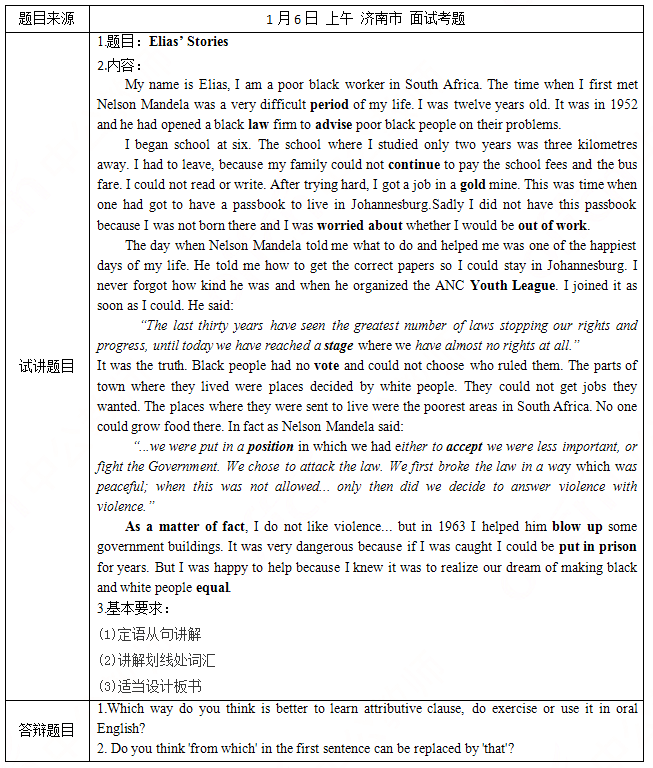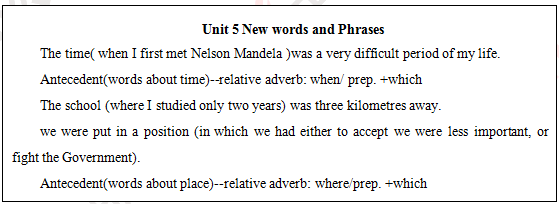Which aspect do students focus on when they learn the usage of vocabulary?A.Spelling. B.Lexical rules. C.Collocation. D.Pronunciation.
题目
B.Lexical rules.
C.Collocation.
D.Pronunciation.
相似考题
更多“Which aspect do students focus on when they learn the usage of vocabulary?”相关问题
-
第1题:
According to The National English Curriculum Standards, the language knowledge students are required to learn consists of phonetics, vocabulary, grammar,__________.A.function and theme
B.culture and society
C.literature and linguistics
D.discourse and genre答案:A解析:考查英语课程标准内容。英语新课标要求的语言知识目标包括:语音、词汇、语法、功能和话题。故选A。 -
第2题:
When teaching the words“so that;therefore”,what content should the teacher focus on?A.Denotative meaning.
B.Usage.
C.Connotative meanings.
D.Learning strategies.答案:B解析:考查词汇教学
题干中说教授so that和therefore的时候,需要老师着重讲解的内容是什么?
黑钻押题,瑞牛题库软件考前更新,下载链接 www.niutk.com
B选项,这两个词意思相同,但是so that常用在口语中,therefore常用在书面语中,因此老师讲解的是词语的用法,符合题意,故此题的正确选项为B。
A选项,词的外延意义,不合题意,故排除。
C选项,词的内涵意义,不合题意,故排除。
D选项,学习策略,不合题意,故排除。
故此题的正确选项为B。
-
第3题:
Teachers who believe in the __________ model will enable students to understand the meaning and usage of the words first, and then make full use of the words in listening, reading or writing tasks, ask representatives to show products of the tasks, and give an evaluation for it at last when teaching vocabulary.A.PPP
B.PWP
C.PPT
D.TBLT答案:D解析:考查词汇教学模式。任务型教学模式(Task-based Language Teaching)是新课标所倡导的一种教学模式。在展示环节,教师通过展示让学生理解词语的意义和用法。任务环节,教师要通过将词汇最大限度置于听读写练习中。汇报环节,学生推举各组代表来展示听读写的任务完成情况。评价和联系环节:教师对学生的任务汇报进行评价.评价他们对新词的使用. -
第4题:
Which of the following should a teacher avoid when his/her focus is on developing students' ability to use words appropriately?A.Teaching both the spoken and written form.
B.Teaching words in context and giving examples.
C.Presenting the form, meaning, and use of a word.
D.Asking students to memorize bilingual word lists.答案:D解析:本题考查语言知识教学。题干的意思:如果教师专注于培养学生恰当地使用单词的能力,那么他/她应该避免以下哪种方式A项“教单词的口语和书面形式”,B项“在语境中教单词并举例子”,C项“呈现单词的形式、意义及用法”,D项“要求学生记忆双语单词表”。在词汇教学中,教师不仅要讲授单词的形式,还要创设具体的语境,让学生在运用中加深对词汇意义的理解,掌握词汇的用法和功能,进而恰当得体地运用词汇表情达意。记忆双语单词表属于单纯的记忆活动,不能起到促进学生恰当使用词汇的作用。故本题选D。 -
第5题:
According to the National English Curriculum Standards, the language knowledge students are required to learn consists of _______ grammar, function and theme.A.phonetics, vocabulary
B.phone, discourse
C.literature, linguistics
D.style, genre答案:A解析:本题考查新课标中的语言知识目标
A选项,英语新课标要求的语言知识目标包括:语音、词汇、语法、功能和话题。综上,A选项正确。
B选项,语音,语篇,故排除。
C选项,文学,语言学,故排除。
D选项,方式,体裁,故排除。
故正确答案为A 项。 -
第6题:
Teachers who believe in the __________ model will enable students to understand the meaning and usage of the words first, and then make full use of the words in listening, reading or writing tasks, ask representatives to show products of the tasks, and give an evaluation for it at last when teaching vocabulary.A. PPP
B. PWP
C. PPT
D. TBLT答案:D解析:考查词汇教学模式。任务型教学模式(Task-based Language Teaching)是新课标所倡导的一种教学模式。在展示环节,教师通过展示让学生理解词语的意义和用法。任务环节,教师要通过将词汇最大限度置于听读写练习中。汇报环节,学生推举各组代表来展示听读写的任务完成情况。评价和联系环节:教师对学生的任务汇报进行评价.评价他们对新词的使用. -
第7题:
How do you decide whether a word should enter the students’ active or passive vocabulary?
We have to consider whether the word:
a) is essential for comprehension of context;
b) is commonly used;
c) is used in a wide variety of situations;
d) has more than one meaning (if so, which; if any, to teach).
If our answer to all these four questions is yes, then we have to make it enter the students’ active vocabulary.
略 -
第8题:
单选题Which aspect do students focus on when they learn the usage of vocabulary?ASpelling.
BLexical rules.
CCollocation.
DPronunciation.
正确答案: D解析: -
第9题:
单选题When a teacher wants to test students' listening skills, grammar, vocabulary and pronunciation, which of the following test format is the most suitable one?ATrue or false questions.
BCompletion.
CDictation.
DTranslation.
正确答案: D解析: -
第10题:
单选题When students learn apple, orange, the teacher gives students another word fruit.Which principle does the teacher follow in his/her vocabulary teaching?AWord-choice principle.
BPresentation principle.
CCulture principle.
DSystematic principle.
正确答案: B解析: -
第11题:
问答题How do you decide whether a word should enter the students’ active or passive vocabulary?正确答案: We have to consider whether the word:
a) is essential for comprehension of context;
b) is commonly used;
c) is used in a wide variety of situations;
d) has more than one meaning (if so, which; if any, to teach).
If our answer to all these four questions is yes, then we have to make it enter the students’ active vocabulary.解析: 暂无解析 -
第12题:
单选题Which of the following should a teacher avoid when his/her focus is on developing students' ability to use words appropriately?ATeaching both the spoken and written form.
BTeaching words in context and giving examples.
CPresenting the form, meaning, and use of a word.
DAsking students to memorize bilingual word lists.
正确答案: A解析: -
第13题:
Which of the following assumptions about vocabulary learning contradicts the modern language teaching theories?A.The best way to learn words is to use them.
B.The best way to learn vocabulary, is via rote-learning.
C.An English dictionary is an important aid to students.
D.Learning a word involves learning more than just the word itself.答案:B解析:考查词汇教学。死记硬背(rote-leaming)并非最佳的学习词汇的方式,它有悖于现代语言教学理论。词汇记忆策包括曲线记忆法、联想记忆法、词典辅助记忆法、语境记忆法等。故选B。 -
第14题:
In a pre-listening activity, students need to learn to cope with some ambiguity in listening and realize that they can still learn even when they do not understand every single word. The aim of this activity is to develop the skill of__________.A. listening for specific information
B. listening for gist
C. listening for structure
D. listening for vocabulary答案:B解析:考查听力教学。在听前活动中,学生需要学会应对听力过程中模糊不清的内容,并且需要意识到当他们不能完全理解每一个单词的时候仍然可以学习。这属于培养学生听主旨的能力,A为听细节.B为听主旨,C为听结构,D为听词汇。故选B。 -
第15题:
Which aspect do students focus on when they learn the usage of vocabulary
A.Spelling.
B.Lexical rules.
C.Collocation.
D.Pronunciation.答案:C解析:考查词汇教学。当学生学习词汇的用法时,学生应注意词汇的搭配(collocation)、短语(phrases)、习语(idioms)、风俗(style)和语域(register)等,故选C。A、B、D三个选项均属于词汇的信息(basicinformation)。 -
第16题:
Which aspect of vocabulary is trained in the following?
The teacher asks the students to read the following passage to tell the writer's attitude towards the woman he is interviewing.
Tall, tanned and debonair, Hazel Henderson is an unlikely revolutionary. She greets me with a warm smile and orders a port of tea, unlike the well-heeled matrons staying at this comfortable hotel.A.Register.
B.Connotation.
C.Collocation.
D.Constitution.答案:B解析:考查词汇教学。通过阅读一段文字来判断作者对所描述人物的态度,这是在帮助学生挖掘词汇的隐含意义,故选B。 -
第17题:
In a pre-listening activity, students need to learn to cope with some ambiguity不明确 in listening and realize that they can still learn even when they do not understand every single word. The aim of this activity is to develop the skill of__________.
A. listening for specific information
B. listening for gist
C. listening for structure
D. listening for vocabulary答案:B解析:考查听力教学。在听前活动中,学生需要学会应对听力过程中模糊不清的内容,并且需要意识到当他们不能完全理解每一个单词的时候仍然可以学习。这属于培养学生听主旨的能力,A为听细节.B为听主旨,C为听结构,D为听词汇。故选B。 -
第18题:
高中英语?语法
一、考题回顾

二、考题解析
【教案】
Teaching aims:
Knowledge aims:
(1)Students are able to master the meaning of bold words and phrases: period, law, advise, gold, worried about, out of work, Youth League, stage, stage, position, as a matter of fact, blow up, put in prison, equal
(2)Students can master the usage of adverb in attributive clause.
(3)After this lesson, students can know the difference of usage of adverb in attributive clause and the usage of pronoun in attributive clause.
Ability aim:
After this lesson, students can use grammar of attributive clause in reading and writing.
Emotional aim:
Students are able to love learning English after this lesson.
Key and difficult point:
Key Point: master the meaning of words and phrases :period, law, advise,gold,worried about etc.
Difficult Point: use grammar of attributive clause in reading and writing
Teaching procedures:
Step 1: Warming-up
1. Greetings.
2. Ask students to make several sentences using the grammar of usage of pronoun in attributive clause. Then write a sentence needing to use adverb in attributive clause. And then lead in the new grammar, adverb in attributive clause.
Step 2: Presentation
1.Ask students to open the book and read the passage to guess the meaning the bold words and then paraphrase the bold words with the help of PPT.
2. Then Ask students to find out more complex sentences that the clause is after a noun or pronoun and the words that are used to introduce the sentences: where, when, why or preposition plus which.
The time( when I first met Nelson Mandela )was a very difficult period of my life.
The school (where I studied only two years) was three kilometres away.
This was time (when one had got to have a passbook )to live in Johannesburg.
we were put in a position (in which we had either to accept we were less important, or fight the Government). ...
Then ask students to find the similarity of these sentences and invite several students to share their ideas. Then lead the students to conclude the rules of relative adverb in attributive clause and preposition plus which in attributive clause. (They all function as adverbials)
Step 3: Practice
1.Make sentences: Ask students to use the grammar that has just learnt to describe the pictures which are presented on the PPT.
2.Combine the sentences: Ask students to combine the sentences according to the grammar in attributive clause.
(1)This is a book. Its cover is blue. (whose)
(2)He is the teacher. He helped me. (who/that)
(3)Beijing is the place. I was born in this place. (where/ in which)
(4)This is the hotel. You will stay at the hotel. (where/at which)
Step4: Production
1.Make stories: Ask students to use the grammar that has just learnt to describe the video.
2.Discussion: Ask students to tell their daily life to use the grammar that has just learnt. And after 5minutes to invite several students to share their daily life.
Step5: Summary and Homework
Summary: ask a student to conclude the content of the lesson and summarize with the whole class.
Homework: write a short passage about his daily life using the grammar that has just learnt.
Blackboard design:

1.Which way do you think is better to learn attributive clause, do exercise or use it in oral English?
2. Do you think 'from which' in the first sentence can be replaced by 'that'?答案:解析:1.
(1)I think, first, the best way to learn attributive clause is tell the definition of this grammar in
sentence. For example, this is a beautiful teacher (who wears the red dress )is our teacher. Then ask students to pay attention to the clause to find the features of this sentence and conclude the attributive clause: noun/pronoun plus a whole sentence. Next tell the usage of pronoun in attributive clause. Last, teach the usage of adverb in attributive clause.
(2) Exercise and oral English should use togerther in practice attributive clasue. Doing exercise can make students master the structure of this grammar easily. And oral English can make students know the real situation of attributive clause in our daily life.
2.
No, I don’t think. From which is an relative adverb from the point of grammar. And that belongs to the pronoun. So it only can be used as the subject, object and so on but can not be used as the adverb or as as phrase. And this sentence doesn’t have the adverb, so we must use from which. -
第19题:
单选题We learn from the passage that _____.AChuck’s students are not clever enough
Bthe students didn’t do Chuck’s homework
CChuck Wall is an unusual teacher
Dno students enjoyed Chuck’s homework
正确答案: C解析:
根据文章的主要内容可知,教授之所以不同寻常,是因为它留作业的方式。故C选项正确。 -
第20题:
单选题In a pre-listening activity, students need to learn to cope with some ambiguity in listening and realize that they can still learn even when they do not understand every single word. The aim of this activity is to develop the skill of________.Alistening for specific information
Blistening for gist
Clistening for structure
Dlistening for vocabulary
正确答案: D解析: -
第21题:
单选题In a pre-listening activity, students need to learn to cope with some ambiguity in listening and realize that they can still learn even when they do not understand every single word. The aim of this activity is to develop the skill of _____Alistening for specific information
Blistening for gist
Clistening for structure
Dlistening for vocabulary
正确答案: A解析: -
第22题:
单选题When students learn apple, orange, the teacher gives students another word fruit. Which principle does the teacher follow in his/her vocabulary teaching?AWord-choice principle,
BPresentation principle.
CCulture principle.
DSystematic principle.
正确答案: D解析: -
第23题:
单选题When a teacher wants to test students' listening skills, grammar, vocabulary and pronunciation, which ofthe following test format is the most suitable one?ATrue or false questions.
BCompletion.
CDictation.
DTranslation.
正确答案: C解析: -
第24题:
单选题When students learnapple, orange, the teacher gives students another word fruit.Which principle does the teacher follow in his/her vocabulary teaching?AWord-choice principle.
BPresentation principle.
CCulture principle.
DSystematic principle.
正确答案: D解析:
